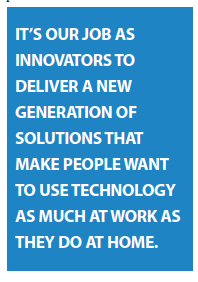 Do you remember when the first Apple iPod was released? The advertisements on television showed beautiful images of rotating color behind a clean silhouette dancing to the sounds coming from the earbuds. It was bold, fresh, and exciting. It was fun. We were not confused by technical specs. We were not overwhelmed by configuration options. We were not dulled by excruciating details regarding power requirements, battery life, or data storage. But we all knew we wanted one. It was small and convenient to carry. It would play the music we loved. And it was beautiful.
Do you remember when the first Apple iPod was released? The advertisements on television showed beautiful images of rotating color behind a clean silhouette dancing to the sounds coming from the earbuds. It was bold, fresh, and exciting. It was fun. We were not confused by technical specs. We were not overwhelmed by configuration options. We were not dulled by excruciating details regarding power requirements, battery life, or data storage. But we all knew we wanted one. It was small and convenient to carry. It would play the music we loved. And it was beautiful.
Because we work in a serious, rigorous, and regulated industry, our technology has naturally reflected this culture. Many of our products are blocky, utilitarian and let’s face it — boring. They may accomplish what they are supposed to, at least often enough to justify their existence, but they are never a joy to use. Rarely do they integrate well, they pay little attention to engaging the user, and ultimately they have not proven to reduce cost, timelines, or frustration the way you would expect — even as technology in our home lives has greatly improved communication and efficiency.
Ultimately, the legacy left us by these technologies is a generation of jaded users. Site staff, monitors, and study teams are wary of new solutions to learn and use at investigator meetings. Too much time becomes wasted either forcing adoption or finding workarounds — time that could be much better spent on patient care and operational logistics.
It’s our job as technology innovators to transform this perception by delivering a new generation of solutions that make people want to use technology as much at work as they do at home.
Winning Back Clinical Trial Practitioners
So how do we win back the trust — and dare I suggest the enthusiasm — of clinical trial practitioners?
Clinical technology providers should learn from successful consumer brands and marketing campaigns such as Apple with its dancing silhouettes. We need to create beautiful technology, too.
Here are some of the key principles and features that we believe make a technology beautiful.
Ease of Use: The ability to get into a system, use it, and get out is one of the single most important factors in a tool’s adoption. If users have to jump through hoops to setup or access their account, hunt for the information they need, or wait on long load times, they will abandon the system — as they should.
 The fault lies in our design and not in any lack of willingness for users to master the intricacies of our technology. Beautiful technology just makes sense.
The fault lies in our design and not in any lack of willingness for users to master the intricacies of our technology. Beautiful technology just makes sense.
Simplicity: A simple design does not indicate a less powerful or valuable solution. The best platforms offer robust toolsets and functions without adding unnecessary noise or layers to the user experience, with a clear goal and a direct path to get there. Beautiful technology makes the complex logic behind its features invisible.
Visually Inviting: It’s no coincidence the best-looking devices and products — whether they are phones, tablets, earbuds, videos, or applications — tend to win the adoption battle over visually other unappealing alternatives which may have more refined features and capabilities.
We’re not creating consumer products, but people like things that look good. A clean interface with pleasing visuals and a smart design has an inherent value that encourages efficiency and raises adoption.
Respects the Current Process: As an industry, we use the word “innovative" a bit loosely. We’re not talking about revolutionary technology here — though it seems that way when compared with the traditional tactic of using enormous teams of people armed with spreadsheets to track critical global activities.
Unfortunately, some of these processes are hard-wired after decades of consistent use, so we can’t expect people to change their ways entirely overnight. That’s why beautiful technology feels familiar.
For example, we replace Excel with an efficient and reliable automated solution that looks like a spreadsheet, and even includes export capabilities, but features elegantly formatted data.
Seamless Integration: You often hear that star athletes make the teammates around them better. We believe beautiful technologies do the same thing. One major reason that we haven’t seen costs decrease as technology usage has increased is that everything is so siloed. The best clinical technologies play well with other systems — even the less beautiful ones — to maximize value. By integrating EDC, IVR, lab, and other third-party data, the next generation of clinical platforms creates a whole greater than the sum of its parts.
We believe that the way to help sponsors, CROs, and sites do more trials is through industry-wide collaboration, standardization, and a beautiful technology experience. Contact us at drugdev.com to begin a conversation about what you think would make clinical technology really sing.(PV)
DrugDev is an innovative technology company that provides cloud-based solutions to help sponsors, CROs, and investigators do more clinical trials together.
For more information, visit drugdev.com.


















